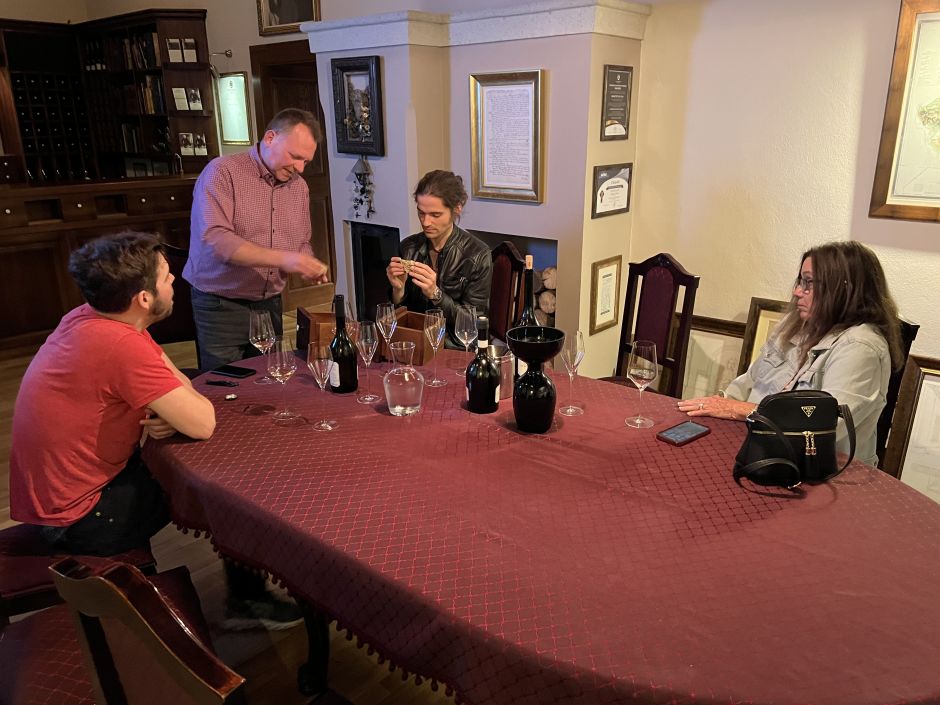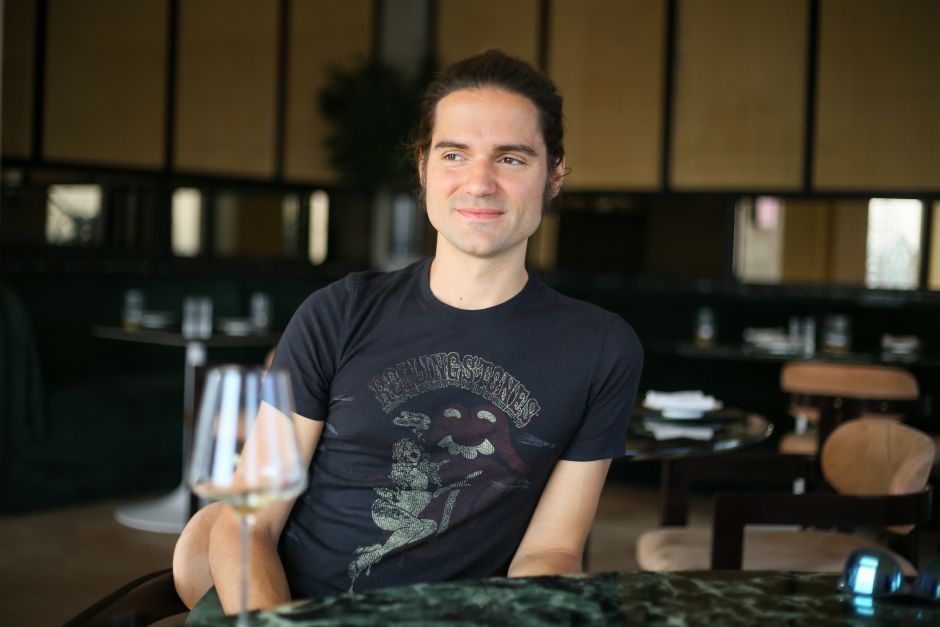
Jerry Cox is a leading fine dining sommelier in New York City, currently working at Saga, a two-Michelin-starred tasting menu restaurant perched on the top floor of a Manhattan skyscraper. Jerry, who completed the theory part of the Master Sommelier Exam, spent three days with me visiting wineries in Tokaj this past spring. I recently sat down with him in Saga, on the 63rd floor of a historic Art Deco building, to chat about our trip.
Why did you decide to visit Tokaj?
My brother, who is also a sommelier, and I were going to Austria for VieVinum, so we were like, “What’s next door? Where else can we go?” It’s not in our normal game plan to be in Eastern Europe, but meeting you earlier reminded me how good Tokaj can be. And Tokaj is a unique place in the wine world.
The Austrian Wine Marketing Board is good at promoting Austrian wines. How did they get you to attend VieVinum?
I’ve known of VieVinum for a long time and I’ve always wanted to attend. It’s the largest showcase of Austrian wine and one of the most important wine fairs in the world. The Austrian Wine Marketing Board has been great about promoting Austrian wines in the United States with tastings, competitions, and providing resources for anyone interested in Austrian wines. In fact, they gave a €650 stipend for my trip to Vienna.
In Hungary, were you thinking of visiting other wine regions, too?
I know there are other areas in Hungary well-known for wine and with beautiful scenery, but Tokaj was the priority for us. Tokaj is the most relevant for the New York market and what we work with mainly.
How did Tokaj compare with other wine regions you’ve been to in Western Europe?
It was very different. A lot of places in France, for example, have been receiving visitors for a very long time, and having people from the United States come is nothing new to them. In fact, part of their business model relies on wine tourism.
In Tokaj, you feel like you’re in a part of the world where not a lot of people are visiting, at least not on the scale seen in the famous wine regions of Western Europe. That these people are farmers, who’re trying to make wine and be commercially viable. There were some exceptions of course, such as Royal Tokaji, Disznókő, and Oremus, which were ready for foreign visitors.
A sense of discovery may not be a bad thing.
Absolutely. Areas that are well-prepared for tourists can feel the same. You aren’t always getting the real culture of a place because they’re trying too hard to show the prettiest side of themselves, show you a fancy tasting room, for example. “Come taste here” signs all along the roads. In Tokaj, we could sense a bit of the historical isolation from this and perhaps the lack of commercial resources.
What was the highlight of your trip?
Realizing the diversity of Tokaj’s wines. With regions that are famous for one style of wine, like Tokaj for the aszú, it’s easy to get lost when you sit down and try to study the whole spectrum of wines and wine laws. You could never have a real understanding of it from here in New York, because you just don’t see many of those wines.
You’ll get to know the aszú from the well-known producers, but not much more. During the Tokaj trip, I was able to taste through many dry wines, see how people are developing their sparkling wines, and appreciate the stylistic differences of the sweets.

You mean the difference between a szamorodni, a fordítás, and an aszú, for example?
Exactly. With the fordítás, I felt like it would be one of those things that’s always just a name on a flash card, worthless information. But I was able to buy a bottle in Tokaj and when we opened it for dinner the other night, I was like, “Wow, who thought I’d ever be drinking this?” Same with the dry szamorodni.
Are the guests at Saga generally open to a Tokaj?
The people who come to Saga have no idea what the food will be, so the type of guest who signs up for this experience is the type of guest who is usually up for anything and receptive to my recommendations.
What’s your pairing recommendation with a 5-puttonyos aszú?
Recently, we had a pop-up of spicy Indian dishes at our sister restaurant. Some of the richer styles of spicy dishes work very well with a 5-puttonyos, because in addition to sweetness, the botrytis brings richness. With dishes that don’t need the weight from alcohol, a bit of sweetness can bring balance. It’s something we are experimenting with. And of course sweeter foods toward the end of the meal are an obvious choice with an aszú.
What do New York fine dining sommeliers think of Tokaj?
Most sommeliers I’ve tasted with would agree that the average Tokaj is better than the average Sauternes. Of course the spectrum of quality and character is wide. When my tasting group was preparing for the Master Sommelier exam, we had a lot of discussion on how to distinguish a Tokaj from a Sauternes.
Please tell me.
Tokaj has that piercing acidity balancing the stone-fruit richness, which the average Sauternes just doesn’t have. Château d'Yquem of course always has good acidity as well, but that’s not the average Sauternes. And Sauternes has this oak character – softness and roundness – from time spent in new barrels, which isn’t the case with Tokaj.

Why isn’t Tokaj more popular then?
I can’t say it’s very trendy, but the people who know it and have experience tasting sweet wines know that in the appropriate context, Tokaj can be among the most delicious wines in the world. That’s why good wine stores in New York, places like Astor and Flatiron, are more receptive to it.
That’s true, but there’s a long way to go.
Other wine regions have similar perception problems. Back in the 1970s, German riesling was the trendiest thing ever, but it drove the quality standards into the ground, and eventually had this reputation of being sweet and not interesting. Now, this has totally reversed. It’s still not the trendiest variety, but people in the business know riesling is the sommelier’s friend and it’s one of the most versatile wines.
Something that could be said about the furmint, too.
Yes. Especially in a place like New York where the trends seem to be constantly evolving and people are always open to something new.
What did you think of the dry wines of Tokaj?
There was a huge spectrum. Some producers made lean, crisp, easy-drinking, lighter, fresher styles. Such as Stephanie Berecz, whose wines were emphasizing citrusy tones, green apple, perhaps trying to replace someone’s easy-drinking sauvignon blanc or chablis.
But then you go to István Szepsy Jr., and clearly his dries are trying to compete with white Burgundies in terms of style. There’s an element of concentration, but still a lot of freshness, mineral tones, and very thoughtful use of oak barrels. And his single-vineyard bottlings have a bit of personality, reflecting the different character of the soil.

So the wines were a bit all over the place.
It might take some time for the broader region to get good at dry wines, because it’s such a new thing in Tokaj. It can take generations for a producer to really understand the given vineyard, the vines, plant the right grapes, and know how to treat them with dry wines in mind.
What kind of dry Tokaj would grab the attention of sommeliers like you?
It would be nice if the producers were on the same page about the basic things – what is unique about a dry Tokaj that we want to express in our wines? Something that isn’t trying to be a white Burgundy or riesling or follow some contemporary trend. We know from the sweet wines that there are many unique things in Tokaj.
I can imagine István Szepsy Jr. leading this effort, because during our visit it seemed that he has done incredibly detailed experiments with the soil and other things. Or Zoltán Demeter, who was fun to listen to and who had a wide spectrum of great wines, especially his sparkling, and strong opinions about everything down to the labeling.
Tokaj’s two main grapes are the furmint and hárslevelű. Were you partial to either?
They seemed quite similar. My theoretical understanding is that the hárslevelű is a little rounder, has a little less of furmint’s piercing acidity, but this wasn’t what I experienced. With the hárslevelű of Stephanie Berecz, for example, I didn’t feel that more subtle acidity at all, and the finished wine seemed remarkably similar to a furmint. But this is just based on my three-day visit.
What food would you pair with a dry furmint?
There are many possibilities. The first dishes that come to mind are salads, delicate fish preparations, and lighter fried foods. Basically anything that could use a squeeze of lemon or lime. Pairing these wines is about figuring out how to use that intensely crisp character of the furmint to add freshness to a dish, or to match the acidity already present in it.
What would someone find you sipping during your off-days?
It’s a cliche, but probably Champagne. Champagne has always been well-known, but we’re just starting to appreciate the smaller producers that are making village and vineyard-specific bottlings. Many of these producers didn’t exist 25 years ago – they were farmers.
But it has become commercially viable for them to make wines that are unique to their area, instead of just selling their grapes to the big houses. We are seeing different fruit characters between villages, even within villages. We’ve been having these conversations about Burgundy forever, but it’s only in the last 25 years that the same thing is happening in Champagne.